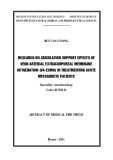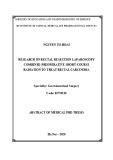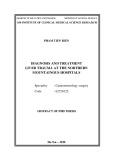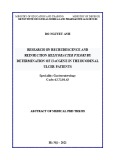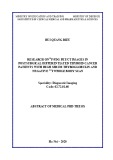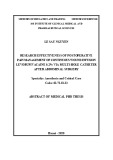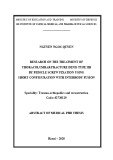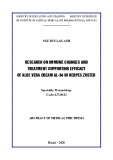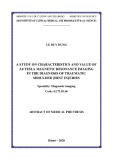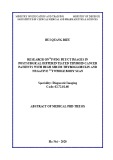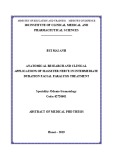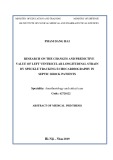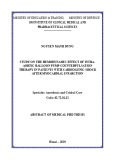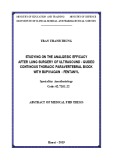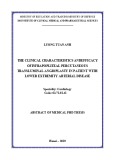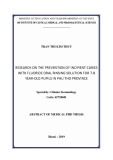MINISTRY OF EDUCATION AND TRAINING MINISTRY OF DEFENCE
108 INSTITUTE OF CLINICAL MEDICAL AND PHARMACEUTICAL SCIENCES
------------------------------------------------- BUI VAN CUONG RESEARCH ON CRICULATION SUPPORT EFFECTS OF
VENO ARTERIAL EXTRACORPOREAL MEMBRANE
OXYGENATION (VA-ECMO) IN TREATMENTING ACUTE
MYOCARDITIS PATIENTS Speciality: Anesthesiology
Code: 62720122
ABSTRACT OF MEDICAL PHD THESIS
Hanoi – 2021
THE THESIS WAS DONE IN: 108 INSTITUTE OF CLINICAL MEDICAL AND PHARMACEUTICAL SCIENCES
Supervisor:
1. Ass Prof. PhD. Le Thi Viet Hoa 2. Ass. Prof. PhD. Dao Xuan Co
Reviewer 1: Ass Prof. PhD. Mai Xuan Hien
Reviewer 2: Ass Prof. PhD. Ha Tran Hung
Reviewer 2: Ass Prof. PhD. Hoang Bui Hai
This thesis will be presented at Institute Council at: 108 Institute of
Clinical Medical and Pharmaceutical Sciences
Day Month Year
The thesis can be found at:
Institute of Clinical Medical and 1. National Library of Vietnam 2. Library of 108 Pharmaceutical Sciences 3. Central Institute for Medical Science Infomation and Tecnology
1
INTRODUCTION
Myocarditis is defined as an inflammation of the myocardium
with the most reason caused by virus. The severe acute myocarditis
such as fluminant myocarditis can lead to cardiogenic shock, life
threatening arryhythmia and death. With the unrespond patients, the
more use vasopressors and inotropic drugs, the more oxygen demand
of myocardium that make the heart injury unrecoverable and the
patients die. Peripheral veno arterial extra corporeal membrane
oxygenation (VA-ECMO) is a form of cardiopulmonary life support,
where blood is drained from the venous system (inferior vena cava or
superior vena cava) circulated outside the body by a centrifugal
pump, and went through oxygenator for oxygenating and CO2 eliminating then reinfused into the circulation throughout arterial
system (most common abdominal arotic artery). Thanks to VA-
ECMO stopped vicious circle of pathogenesis and waiting of
myocardial recovery. Nowadays, the studies showed that VA-ECMO
has efficacy on acute myocarditis with the 60-70 % survival rate. In
Viet Nam, there have been a fews studies about this issue, therefor
we perfrom the study:
“Research on circulation support effects of veno-arterial
extracorporeal membrane oxygenation (VA-ECMO) in treatmenting
acute myocarditis patients” with two objectives:
1. Evaluate the improvements of circulation, arterial blood gas,
organ function of veno arterial extracorporeal membrane
oxygenation (VA-ECMO) in treatmenting acute myocarditis patients.
2
2. Remark some prognostic factors of mortality and
complications of veno arterial extracorporeal membrane oxygenation
for acute myocarditis patients.
* The urgency of study:
Acute myocarditis is a acute myocardium injury with clinical
presentations of the disease range from nonspecific systemic
symptoms that it resolves spontaneously to fulminant cardiogenic
shock, life threatening arryhythmias such as ventricular tachycardia,
ventricular defibrillation and cardiac arrest. It had high mortality
approximately 50% and it is common in young people. Nowadays
the studies showed that VA-ECMO has efficacy on acute
myocarditis, ICU in Bach Mai hospital is implementing VA-ECMO
for acute myocarditis but there have been a fews studies about this
issue, therefore we perform this study for evaluating the efficacy and
complications of veno arterial extra corporeal membrane
oxygenation (VA-ECMO) in treatmenting acute myocarditis patients.
* The novelty of study:
- The results of study showed that the VA-ECMO was highly
effective in acute myocarditis patients having complications
cardiogenic shock and life threatening arryhythmias.
- The results of study revealed some prognostic factors of
mortality in VA-ECMO supported acute myocarditis patients.
- The results of study found that the most bleeding complication
was ECMO cannula site.
* The lay-out of thesis: There are 127 pages including introduction
2pages, overview 36 pages , materials and methods 21page, results
25 pages, discussion 40 pages, conclusion 2 pages, and request with
31 tables, 10 charts and 10 graphs in suitable structure. There were
3
119 references including 2 Vietnamese references and 117 English
references.
CHAPTER 1: OVERVIEW
1. ACUTE MYOCARDITIS
1.1. Definition and pathophysiology
Myocarditis is defined as an inflammation of the cardiac
muscle. Acute myocaditis account for 6% cause cardiogenic shock.
Clinical presentations of the disease range from nonspecific systemic
symptoms that it resolves spontaneously to fulminant cardiogenic
shock, life threatening arryhythmia and cardiac arrest. Based on
observations of acute myocarditis due to coxsackie virus in humans
as well as in mice, acute myoarditis caused by virus is a continuum
of distinct disease processes including 3 phases. The first phase is
viral infection and replication in myocardium. Viral proteolysis and
cytokine activation cause myocardial damage leading apotosis. It is
difficult to recognise this phase by clinical sign because of the
patients having asymptomatic or unspecific clinical. The second
phase involving the host’s immune activation, it simulates cellular
and humoral immune responses that reduces viral replication leading
to myocardial recovery. However, immune activation is not
decreasing possibly due to the activation of T cells against
myocardium throughout the peptides of viruses. This leading to
release cytokines such as tumor necrosis factor (TNF), IL-1, and IL-
6 resulting in more myocardium damage. Overactivation of cellular
immunity or viruses are not completedly eliminated and continue
replicating leading the third phase. This phase, left ventricle was
enlarged due to remodeling phenomenon, it causes left ventricle
4
function disorder and heart failure. If the inflammatory decreases, the
left ventricle function will improved but the continuing inflammatory
leading to dilated cardiomyopathy.
1.3. Main treatment
1.3.1. Respiratory support: depend on patients that need nasal
cannula, mask cannula, non invasive ventilation and invasive
ventilation.
1.3.2. Circulation support: fluid resuscitation, vasopressor agents
1.3.3. Mechanical circulatory support
Mechanical circulatory support is indicated if the
cardiogenic shock patients did not response with conventional
treatment. VA-ECMO is the best choice in this acute myocarditis
patients complicated cardiogenic shock and life threatening
arryhythmias.
- VA- ECMO systems
Peripheral veno arterial extracorporeal membrane
oxygenation (VA-ECMO) is a form of cardiopulmonary life support,
where blood is drained from the big venous system, circulated
outside the body by a centrifugal pump, and then reinfused into the
circulation throughout big arterial system. ECMO system including
ECMO machine, circuit and cannula. The blood goes through
oxygenator eliminated CO2 and oxygenated and return to patient. The advantage of ECMO system can setup quickly, bedside for
supporting patients for some weeks.
1.4. Efficacy of ECMO study on acute myocardtis patients
According to Yih, the fours survivors accouting for 80 percents
were discharged and the TnT level declined to the low level within
3 days might be an indicator of good recovery but the study
5
limitation was the small patient numbers so it was difficult to reach
statistical significance. Chen study showed that 14 (93.3%) of the
15 patients could be weaned off VA-ECMO, and the survival rate
was 73.3% (11 of 15) without transplantation. One of four patients
died of severe brain damage because of prolonged cardiopulmonary
resuscitation. The survival rate in Matsumoto study 70.2% (26 of
37 patients), four of fifteen unweaned group switched from VA-
ECMO to left ventricle assist device were survival after heart
tranplantation or continuous treatment. Aoyama study revealed the
survival rate was 57.7% and EF before ECMO and acute kidney
injury complication of the mortality group were more severe. The
survival rate of Diddle study was 61%, but the patients having
acute kidney injury had higher mortality with OR 3.6, CI 1.4-9.3,
CI 95%. According to X.Liao, 78.8% surviaval rate, before ECMO
serum lactate concentration was very high. The patients having
high quantities of blood product transfusion, renal failure,
encephalorrhagia, high bilirubin levels, or multiple organ failure
(MOF) during ECMO were associated with poor outcome. Wigfield
study found that main factor caused death in VA-ECMO patients
was MOF.
CHAPTER 2: MATERIALS AND METHODS
2.1. Inclusion criteria
a/ The patients suffered from acute myocarditis by 2013 the
European Society of Cardiology’s criterion were admitted ICU Bach
Mai hospital from 2015-2018.
- Clinical presentations new onset acute chest pain, pericarditic, or
pseudo-ischaemic or worsening of: dyspnoea at rest or exercise,
6
and/or fatigue, with or without left and/or right heart failure signs
and/or unexplained arrhythmia symptoms and/or syncope, and/or
aborted sudden cardiac death or unexplained cardiogenic shock
- Newly abnormal 12 lead ECG or elevated TnT/TnI cardiac
markers, functional and structural abnormalities on cardiac imaging
(echo/angio/CMR).
- Exclusion criteria: angiographically detectable coronary artery
disease (coronarystenosis ≥50%); known pre-existing cardiovascular
disease or extra-cardiac causes that could explain the syndrome
b/ And suffered from cardiogenic shock by 2012 the European
Society of Cardiology’s criterion
- Hypotension: systolic blood pressure < 90mmHg for 30
minutes, or vasopressors required to achieve a blood pressure ≥ 90
mmHg
- Evelated left ventricular filling pressure: pulmonary congestion
or adequate or elevated filling pressure (wedge pressure > 20 mmHg)
- Signs of impaired organ perfusion (at least one of the
following): altered mental status, cold, clammy skin, oliguria,
increased serum lactate levels.
c/ And IE ≥ 40 g/kg/minutes and/or life threatening criteria such as
ventricular tachycardia, ventricular fibrillation or cardiac arrest.
2.1.2. Exclusion criteria
- The aortic artery dissection patient
- Patient or patient’s family doesn’t agree with taking part the
study
- Cardiogenic shock in HIV-AIDS or end state cancer patients
2.3. Methods
2.3.1. Study design: progressing, intervention and before-after study
7
2.3.2. Sample size: Formular N= 2C x (1-r)/ (ES)2
N: estimated sample size, C: constant of type I, II error, r:
relative coeficient, là hệ số tương quan giữa 2 đo lường, ES : effect
size . In our study : C = (Zα/2 + Zβ) 2 with α = 0.05, β = 0.20 thì C =
7,85 , r= 0,6 and ES= 0,41 (current study mortality rate is 50%, expection
mortality rate 30%) => N= 37. With an estimated 10% loss rate so the
sample size was 37/0,9 = 42 patients.
2.3.5. The variables of study
2.3.5.1. Charateristics of patient and ECMO parameters
- Name, family name, age, gender, weight, past medical history
(healthy, heart failure, hypertension, COPD), fever, dyspnea, chest
pain, cold, clammy skin, cardiac arrest, vasopressor and inotropic
dose, IE index, SAVE score, APACHE II score. ECG on admission,
ventricular fibrillation, ventricular tachycardia, ventricular
extrasystole, third-degree AV block, atrial rhythm, sinus rhythm.
ECMO cannulation techniques (percutaneous or surgery
cannulation). The duration of ECMO, the number of membranes,
CO, flow, FiO2 of ECMO. 2.3.5.2. The improvenments of circulations
-Pulse, MAP, pulse pressure, vasopressor and inotropic dose,
ECG, CK, CKMB, Troponin T, proBNP EF, Dd, Ds, right heart
diameter before ECMO, day 2, day 3, day 4, day 5 and stopped
ECMO
- LVOT_CO, VTI, TAPSE on stopped ECMO.
2.3.5.3. The improvement of arterial blood gas
-ABG: pH, pCO2, PaO2, HCO3, lactate before ECMO, day 2, day 3, day 4, day 5 and stopped ECMO
2.3.5.4. The improvement of organ function
8
SOFA score before ECMO, day 2, day 3, day 4, day 5 and
stopped ECMO
2.3.5.5. Some prognostic factors of mortality
SOFA score, APACHE II score, SAVE, pulse pressure on day 5,
cardiac arrest and serum lactat associated with mortality rate.
2.3.5.6. Some comlications of VA-ECMO
- Lower limb arterial thrombosis complication on the ECMO
cannulation site
- Infection:
+ General infection: temperature, white blood cell, procalcitonin
before ECMO, day 2, day 3, day 4, day 5 and stopped ECMO
+ Infection of ECMO cannula site,
- Neurologic complication
- Bleeding: ECMO cannula site, central line site, arterial line,
gastrointestinal bleeding. Coagulation factors associated
complications such as PT, APTTs, fibrinogen, D-dimer, ethanol test
before ECMO, day 2, day 3, day 4, day 5, stopped ECMO and one
day later stopped ECMO.
- Heparin dose: bolus dose, day 1, day 2, day 3, day 4, day 5 and
stopped ECMO
- Acute pulmonary edema, CRRT
2.4. The definition of score, criteria in research
- CDC Criteria of Surgical Site Infection
Date of event occurs within 30 days after any NHSN operative
procedure and involves only skin and subcutaneous tissue of the
incision and patient has at least one of the following: a. purulent
drainage from the superficial incision. b. organism(s) identified from
an aseptically-obtained specimen from the superficial incision or
9
subcutaneous tissue by a culture or nonculture based microbiologic
testing method which is performed for purposes of clinical diagnosis
or treatment (for example, not Active Surveillance Culture/Testing
(ASC/AST)). c. superficial incision that is deliberately opened by a
surgeon, physician or physician designee and culture or non-culture
based testing of the superficial incision or subcutaneous tissue is not
performed AND patient has at least one of the following signs or
symptoms: localized pain or tenderness; localized swelling;
erythema; or heat. d. diagnosis of a superficial incisional SSI by a
physician or physician designee.
- Lower limb arterial thrombosis complication on the ECMO
cannulation site: found durring stopped ECMO or ultrasound.
- neurologic complications: cerebral haemorrhage and cerebral
infarction: found signs on MRI or CT
- Bleeding: the bleeding clinical signs of ECMO cannula site, central
line site, arterial line. gastrointestinal bleeding based on clinical signs
and endoscopy.
- Acute kidney injury: RIFLE classification
- Organ failure: SOFA score
2.5. Collect data for the study following the medical report form
2.6. Data analysis: following medical statistic method
CHAPTER 3: STUDY RESULTS
3.1. Characteristics of patients
From 2015-2018, there were 54 patients having full criteria’s
for inclusion: female 66.7% (36 patients), average age 35.6 11.17
years old (min 18- max 67), 18 cardiac arrest patients (33.3%).
10
Table 3.1: Some indexes of patients before ECMO
p
Total ( X ±SD)
Survival ( X ±SD)
Non-survival ( X ±SD)
APACHE II
10.3±5.45 (n=54) 8.9±4.43 (n=44) 16.4±5.52 (n=10) <0.05
7.8±2.68 (n=54) 7.4±2.68 (n=44) 9.6±2.01(n=10) <0.05
SOFA before ECMO Lactat (mmol/l)
7.60±4.47 (n=54) 7.2±4.08 (n=44) 9.05±5.94 (n=10) >0,05
EF (%)
33.2± 13.55 39.8± 15.46 (n=8) >0.05
SAVE
<0.05
Troponin T (ng/L)
>0.05
<0.05
34.3±13.92 (n=49) Median: 2.5 (n=54) Median 4409 (n=53) Median 35 (n=18)
Median 5 (n=44) Median 4409 (n=43) Median 30 (n=11)
Median -3 (n=10) Median 4756 (n=10) Median 40 (n=7)
The duration of cardiac arrest (minutes)
Remark: SOFA score, APACHE II score, serum lactate,
Troponin T profoundly increased and EF dramatically decreased, the
median time of cardiac arrest was 31 minutes, these showed that the
patients having severe myocardial injury and cardiogenic shock.
Chart 3.1: The duration of ECMO and the number of membrane
Remark: 95% patients were supported VA-ECMO within 2
weeks, almost cases only used one membrane.
11
3.2. Objective 1: The improvements of circulation, arterial blood
gas, organ function
3.2.1. The improvenments of circulations
Chart 3.2: Change in blood pressure, mean arterial pressure,
inotropic equivalents during ECMO
Remark: MAP improved on VA-ECMO day 2 and stably
maintained during ECMO, pulse pressure was enormous fallen after
ECMO support and returned on day 5 and significantly rised on
stopped ECMO day. IE index rapidly delined after ECMO
commencement.
12
Table 3.2: Change in serum lactate during ECMO
Median (Interquartile range)
p
Before ECMO (n=54)
7.55 (3.5-10.9)
ECMO day 2 (n=52)
1.90 (1.4-2.7)
<0.05
ECMO day 3 (n=50)
1.85 (1.1-2.4)
<0.05
ECMO day 4 (n=50)
1.75 (1.1-2.7)
<0.05
ECMO day 5 (n=47)
1.56 (1.0-2.4)
<0.05
Stopped ECMO (n=54)
1.35 (0.8-2.5)
<0.05
*p<0.05 compare with T0 with others
Remark: serum lactate concentration significantly dropped
after ECMO
Chart 3.3: The change in ECG during ECMO Remark: The result showed that ventricular tachycardia, third-
degree AV block and sinus rhythm were nearly 53%, 40% on
admission respectively. 31.5 % patients had elevated ST segment.
13
Table 3.3: Change in cardiac marker during ECMO
Troponin T (U/L)
Median
p
Interquartile range
4409.0 (n=53)
(2755.0-7369.5)
Before ECMO
3690.0 (n=53)
(1535.5-6744.0)
<0.05
ECMO day 2
2320.0 (n=51)
(1010.0-5385.0)
<0.05
ECMO day 3
1420.0 (n=51)
(450.0-3450.0)
<0.05
ECMO day 4
840.0 (n=46)
(302.0-2162.2)
<0.05
ECMO day 5
259.0 (n=54)
(115.8-1810.0)
<0.05
Stopped ECMO
*p<0.05 compare with T0 with others
Remark: Troponin T remarkably decreased from day 3 to stopped
ECMO day.
p Table 3.4: Change in EF (%) during ECMO ±SD) Min-max
Before ECMO (n=49) ECMO day 2 (n=53) ECMO day 3 (n=52) ECMO day 4 (n=51) ECMO day 5 (n=47) Stopped ECMO (n=51) 10-72 10-41 11,5-63 6.7-55.0 12-60 17-72 <0.05 <0.05 <0.05 >0.05 <0.05 ( 34.313.92 22.06.67 24.19.96 27.19.74 33.012.5 47.713.91 *p<0.05 compare with T0 with others
Remark: EF significantly reduced after ECMO support and returned
on stopped ECMO day.
14
3.2.2. The improvement of arterial blood gas
Table 3.5: The change in arterial blood gas during ECMO
PaO2 (mmHg) Median (IQR)
pH ( X ±SD)
Before ECMO ECMO day 2 ECMO day 3 ECMO day 4 ECMO day 5 Stopped ECMO
133.5 (n=52) (80.2-304.2) 205,5 (115.2-331.7)* 146.0 (n=50) (113.7-249.7) 140.5 (n=50) (106.0-140.5) 141.0 (n=47) (97.0-208.0) 153.5 (n=54) (104.7-213.2)
PCO2 (mmHg) ( X ±SD) 32.614.30 (n=54) 32.66.30 (n=52) 35.67.67* (n=50) 34.96.60* (n=50) 35.56.99* (n=47) 35.46.62 (n=54)
HCO3 (mmol/l) ( X ±SD) 16.14.88 (n=53) 23.14.31* (n=52) 26.05.40* (n=50) 26.85.31* (n=50) 27.35.01* (n=47) 25.36.66* (n=54)
7.300.14 (n=54) 7.450.09* (n=52) 7.470.09* (n=50) 7.490.08* (n=50) 7.490.06* (n=47) 7.440.12* (n=54) *p<0.05 compare with T0 with others
Remark: Metabolic acidosis was tremendous improved after ECMO
3.3. The improvement of organ function
Table 3.6: Change in SOFA score during ECMO
Min-max
p
Before ECMO (n=54)
4-17
( X ±SD) 7.82.68
ECMO day 2 (n=53)
>0.05
4-17
8.62.76
ECMO day 3 (n=52)
<0.05
4-17
9.22.86
ECMO day 4 (n=52)
<0.05
4-17
9.62.44
ECMO day 5 (n=47)
<0.05
5-16
9.82.74
Stopped ECMO (n=54)
<0.05
5-23
9.93.26
<0.05
0-10
4.52.31
SOFA after stopped ECMO 1 day (n=44)
*p<0.05 compare with T0 with others
Remark: SOFA score did not go down during VA-ECMO even
slightly increase but profoundly decreased after stopped ECMO one
day.
15
3.3. Objective 2: Some prognostic factors of mortality and
complications of VA-ECMO
3.3.1. Some prognostic factors of mortality
- The survival rate was 82.14%
3.3.1.1. Cardiac arrest associated with mortality rate
Table 3.7: Cardiac arrest associated with mortality rate
OR CI-95%
Survival (n=44) 11 (25%)
Non-survival (n=10) 7 (70%)
7.14
Cardiac arrest
0.03-0.65
Non- cardiac arrest
33 (75%)
3 (30%)
Remark: The mortality rate in cardiac arrest patients was 7,14 times
as many as the mortality rate in non-cardiac arrest patients.
3.3.1.2. Pulse pressure associated with mortality rate
Table 3.8: Pulse pressure associated with mortality rate on day 5
OR
CI-95%
Survival n (%)
Non-survival n(%)
>20
31 (96.8)
1 (3.2)
12.5
0.01-0.8
<=20
10 (71.4)
4 (27.8)
Pulse pressure on day 5 (mmHg)
Remark: The mortality of patients having pulse pressure less than
20 mmHg on ECMO day 5 was 12.5 times higher than patients
having pulse pressure greater than 20 mmHg
16
Chart 3.4: SAVE and serum lactat associated with mortality
Remark: SAVE score with cut-off -8 point having sensitivity 87%,
specificity 90% and AUC 0.934 for mortality prediction
3.3.2. Some complications of VA-ECMO
Bleeding site
Arterial line site
Central line site
GI bleeding
Cerebral hemorrhage
Time
20 (37) 31 (57.4) 32 (59.3) 33 (61.1) 31 (57.4) 28 (51.9)
2 (3.7) 3 (5.6) 2 (3.7) 3 (5.6) 6 (11.2) 5 (9.3)
n=(%) 10 (18.5) 17 (31.5) 10 (18.5) 16 (29.6) 17 (31.5) 25 (46.3)
0 (0) 2 (3.8) 0 (0) 2 (3.8) 0 (0) 0 (0)
0 (0) 0 (0) 0 (0) 0 (0) 0 (0) 0 (0)
Table 3.9: Bleeding complications ECMO cannula site
ECMO day 1 ECMO day 2 ECMO day 3 ECMO day 4 ECMO day 5 Stopped ECMO
Remark: The most bleeding complications were ECMO cannula site
and arterial line site, the highest bleeding rate on ECMO day 4 and
on stopped ECMO day were 61.1%, 46.5% respectively.
17
Chart 3.5: Lower limb arterial thrombosis complication
Remark: Lower limb arterial thrombosis complication during
stopped ECMO was twice as many as after the arterial thrombosis
complication stopped ECMO. There was not signicantly different the
lower limb arterial thrombosis rate between percutaneous ECMO
cannulation and surgery ECMO cannulation.
3.3.2.5. Acute pulmonary edema and neurologic complications
- Acute pulmonary edema: 16/54 (29.6%)
- Cerebral infarction: 01 case
CHAPTER IV DISCUSSION
4.1.1. Characteristics
54 acute myocarditis patients with mean age 35.6 (min 13-max
67), 31-50 range having 57.4%, and female accounted for 66.7%,
the results was similar to the other authors. Almost acute
myocardisits patients were female, some studies showed that the
male-female ratio may be different but young people suffered from
acute myocarditis higher than the elder did.
18
The results showed that almost patients with cardiogenic shock
complicated multiple organ failure syndrome (MOFS), their
APACHE II, SOFA score and serum lactate were 10.3 5.45, 7.8
2.68, 7.6 4.47 mmol/l, respectively. The high serum lactate
concentration reflected the severe cardiogenic schock leading tissue
hypoperfusion. Troponin T profoundly increased to 4409.0 ng/L
because of severely myocardial necrosis. Although the patients was
supported high dose vasopressors, EF was only 34.313.92 (%). 18
patients (33.3%) having cardiac arrest.
4.1.2. The ECMO duration and number of ECMO membrance
ECMO duration in this study was 7.6 2.9 days, one patient did not
respone, did not maintain blood pressure and died that only supported
ECMO more than one day. Subgroup analysis showed that 34 patients
(63%), 17 patients (31.4%) and 3 patient were supported less than 7
days, from 8- 14 days, greater than 14 days respectively. According to
these results, the ECMO duration of nearly two third acute myocarditis
patients within one week.
4.2. Objective 1: The improvements of circulation, arterial blood
gas, organ function
4.2.1. The improvements of circulation
Desipte high dose vasopressor with median 70 μg/kg/minute,
mean arterial pressure’s patients before ECMO 62.4 24.60 mmHg.
After ECMO, mean arterial pressure (MAP) incresased significantly
that was 76.79.93 mmHg. Before ECMO, pulse pressure was
33.714.85 mmHg and it dramatically decreased with median 14 on
ECMO day 2, after that is returned from day 3, especcially highest
value on stopped ECMO day.
19
Before ECMO the serum lactate concentration median was
7.55 mmol/l and markedly decreased on day 2 with median 1.9
mmol/l which demostrated better tissue perfusion and higher MAP.
There were 18 ventricular arrhythmia patients (33.3%), 3 ventricular
extrasystole patients, 11 third-degree AV block patients (20.4%) and
22 sinus rhythm patients on admission. It mean that nearly a half
patients having life threatening arrhythmia. The median of Troponin
T profoundly decreased from 4409.0 ng/L on admission to 259.0
ng/L on stopped ECMO day. It reflected that the myocardial necrosis
was deacreasing.
Although the patients was supported high dose vasopressorss, EF
was only 34.313.92 (%) so the actual EF value without vasopressors
was very low. EF significantly reduced after ECMO and was 33.012.5
(%) on ECMO day 5 without or minimum dose vasopressors.
4.2.2. The improvement of arterial blood gas
Before ECMO, because of severe cardiogenic shock arterial
blood gas was severe metabolic acidosis with pH 7.30.14, PaCO2
32.614.3 mmHg và HCO3 16.14.88 mmol/l, the metabolic acidosis sharply improved from ECMO day 2.
4.2.3. The improvement of organ function
In this study, Having been 7.82.68 before ECMO, SOFA
score did not change sifnificantly during ECMO, even slightly
increased because of the two things, the first if the patients had
acute kidney injury, they need severe weeks for recovering, the
second before ECMO the patient’s platelet was 19271.2 G/l,
after ECMO support, the platelet was 11146.0 G/l on ECMO day
2 and 8943.3G/l on stopped ECMO day, however after one day
20
SOFA score rapidly declined with mean 4.52.31 owing to
improved cardiovascular and coagulation score
4.3.1. Some prognostic factors of mortality
The survival rate was 82.14%, it was higher than the other
author’s rate. The high survival rate showed that the recovery of
myocardium in the group of acute myocarditis is higher than the
other causes’s recovery.
In our study, before ECMO there were 11 cardiac arrest patients
in the survival group and 7 in the non survival group, the cardiac
arrest associated with mortality rate in the non survival group was
nearly 70% and the mortality rate in cardiac arrest patients was 7.14
times as many as the mortality rate in non-cardiac arrest patients
Pulse pressure associated with mortality rate on day 5, the
mortality of patients having pulse pressure less than 20 mmHg on
ECMO day 5 was 12.5 times higher than patients having pulse
pressure greater than 20 mmHg (CI 95%, p=0.008). Pulse pressure
was related to the myocardium recovery, the lower pulse pressure,
the more severe heart function.
The study revealed that mean SAVE score was 2.5±4.37,
The prediction of mortality of SAVE score was higher than
prediction of mortality of APACHE II score, serum lactate
concentration and SOFA score. SAVE score with cut-off point -8
having sensitivity 87%, specificity 90% and AUC 0.69 for mortality
prediction.
4.3.2. Some complications of VA-ECMO
4.3.2.1. Bleeding complications
In this study, the ECMO cannula bleeding complication on
ECMO day 2, day 4 and on stopped ECMO day were 37%, 61.5%
21
and 51.8% respectively. The lower rate of bleeding complication was
arterial line site that was 18.5% on ECMO day 2 and 46.2% on
stopped ECMO day, while the lowest rate was central line site,
12.5% on ECMO day 5. It was explained that the size of ECMO
cannula which was 16 F was much bigger than arterial line and
central line’s sizes, moreover the pressure of femoral artery was
very high that was the reason make not only higher bleeding
complication rate but also more severe bleeding quantity in ECMO
cannula site.
4.3.2.2. Lower limb arterial thrombosis complication
In our study, No severe lower limb arterial thrombosis
complication during ECMO that need intervention, however 5 cases
whom had lower limb arterial thrombosis after stopped ECMO by
ultrasound was treated by anticoagulant agents. During stopped
ECMO, 12 patients (21.2%) found lower limb arterial thrombosis
and it was removed by cardiac surgeon.
4.3.2.3. Acute pulmonary edema and neurologic complications
16 patients (29.6%) had acute pulmonary edema found by
clinical signs such as bloody frothy sputum through out endotube, it
may be involve left ventricle distension because during VA ECMO,
the arterial outflow cannula generates retrograde flow towards the
AV, resulting in higher afterload and increased left ventricular end
diastolic pressure. For markedly decreased ejection fraction patients,
VA-ECMO can cause increased left ventricle wall tension and
myocardial oxygen demand that made more severe acute pulmonary
edema and more severe outcome.
In our study, only 1 patient had cerebral infraction, however it is
certain that 44 survival patients (81.5%) without sneurologic
22
sequelae so we can completely ruled out neurologic in these patients.
The remaining 9 death patients, we could not rule out whether the
patient had a neurologic complications event or not because of
patient's severe condition that did not allow performed brain CT
scan.
CONCLUSION
With 54 VA-ECMO supported acute myocarditis patients,
our study showed that:
1/ The improvements of circulation, arterial blood gas, organ
function
VA-ECMO helped improve circulation parameters, arterial
blood gas, organ function in acute myocarditis patients.
- The improvements of circulation
+ VA-ECMO helped increased mean arterial pressure,
decreased heart rate and inotropic equivalent index. Pulse pressure
was enormous fallen after ECMO support and returned significantly
on stopped ECMO day (p<0.05).
+ The serum lactate concentration significantly decreased after
ECMO with the it’s median before ECMO support and stopped
ECMO day were 7.55 mmol/l, 1.35 mmol/l respectively (p<0.05).
+ There was a significant drop Troponin T from ECMO day 3,
the median of Troponin T before ECMO, on day 3, on stopped
ECMO day were 4409.0 (U/L), 2320.0 (U/L) and 259.0 (U/L)
(p<0.05)
+ EF profoundly decreased from 34.4 ± 13.92% to 22.0 ±
6.67% (p<0.05) and it’s mean significantly increased to 47.7± 3.91%
on stopped ECMO day.
- The improvement of arterial blood gas: Metabolic acidosis was
23
tremendous improved after ECMO, pH before ECMO and stopped
ECMO day were 7.300.14 and 7.440.12 respectively (p<0.05).
- The improvement of organ function: SOFA score did not go down
during VA-ECMO, 7.82.68 before ECMO and 9.9 ± 3.26 on stopped
ECMO day but profoundly decreased after stopped ECMO one day
4.52.31 (p<0.05).
2. Some prognostic factors of mortality and complications of VA-
ECMO
- Some prognostic factors of mortality
+ The survival rate was 82.14%
+ The mortality rate in cardiac arrest patients before ECMO was
7.14 times as many as the mortality rate in non-cardiac arrest patients
(OR 7.14, CI 0.03-0.65)
+ The mortality of patients having pulse pressure less than 20 mmHg
on ECMO day 5 was 12.5 times higher than patients having pulse
pressure greater than 20 mmHg (OR 12.5, CI 95%, p=0.008).
+ SAVE score with cut-off point -8 having sensitivity 87%, specificity
90 % and AUC 0.934 for mortality prediction.
- Some complications of VA-ECMO
+ The most bleeding complications were ECMO cannula site and
arterial line site, the highest bleeding rate on ECMO day 4 and on
stopped ECMO day were 33 cases (61.1%) , 25 cases (46.5%)
respectively.
+ Lower limb arterial thrombosis complication found 22.2% cases
during stopped ECMO
+ The rate of patients having DIC score greater than 5 was 18.5% on
before ECMO, highest rate 55.6% on ECMO discontinuation day
and significantly decreased 9.5% 24 hours later (p<0,05)
24
+ ECMO cannula site infection: 16.1%
+ Acute kidney injury: 42.5%
PROPOSALS
1. VA-ECMO should be appied for acute myocarditis patients
complicated cardiogenic shock, life threatening arryhythmias and
carefully considered in cardiac arrest patients
2. Monitong coagulation tests by using ACT, ROTEM to
titrate quickly anticoagulant agents dose and treat coagulation
disorders, bleeding.
LIST OF PUBLISHED ARTICLE RELATING TO THESIS
1. Bui Van Cuong , Le Thi Viet Hoa, Dao Xuan Co (2020), “the
assessment of clinical outcomes of veno- arterial extracorporeal
membrane oxygenation in adult patients with cardiogenic shock
due to acute myocarditis”, Jounal of 108 – Clinical Medicine
and Pharmacy, (15), pp. 42-47.
2. Bui Van Cuong, Le Thi Viet Hoa, Dao Xuan Co (2020), “some
complications of veno- arterial extracorporeal membrane
oxygenation in cardiogenic shock patients due to acute
myocarditis”, Jounal of 108 – Clinical Medicine and Pharmacy,
(15), pp. 31-37.

